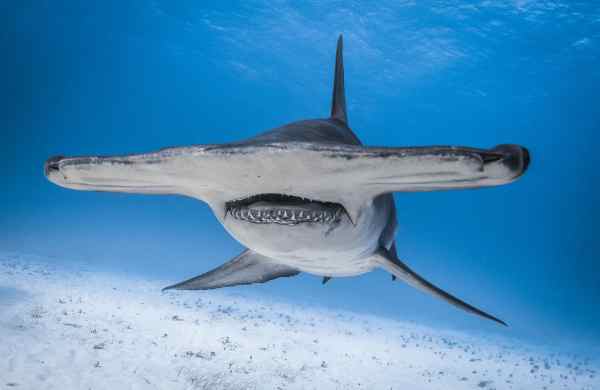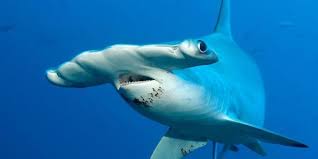Diving with hammerhead sharks is undoubtedly one of the most thrilling experiences a scuba diver can have. The first time you come face to face with one of these bizarre creatures is unforgettable; they look like something straight out of a science fiction movie! However, beyond their unusual appearance, hammerhead sharks are incredible animals that need to be seen and protected in the wild.
Table of Contents
And while many destinations worldwide offer the opportunity to encounter these magnificent creatures, certain locations are renowned for swarms of hammerheads that you won’t soon forget. If you’re looking for an adventure like no other, consider diving with hammerheads in one of the world’s best locations.
All about Hammerhead sharks
As you dive into the warm waters of the ocean, it’s hard not to be entranced by the graceful movements of the Hammerhead shark. These animals are truly one of the most evocative in our seas, with a striking appearance that is both captivating and unique. Their distinctive hammer-shaped heads cut through the water with ease, drawing the eye and leaving an indelible impression on all who are fortunate enough to witness them in the wild.

Distinguishing features
Hammerhead sharks are unmistakable thanks to their unique hammer- or shovel-shaped head. It’s an extraordinary flattened shape known as the cephalofoil, which is believed to be linked to enhanced vision and sensory perception. With eyes on either end of their head, Hammerheads can see better than most sharks, giving them an improved chance of finding prey.
What’s more, they also have many sensors along the width of their head, which send out electrical charges to locate game buried underneath the sand. While there might be nine types of Hammerheads, they all share this distinguishing hammer-shaped head that serves as their primary hunting tool.
Conservation
Hammerheads are some of the most remarkable creatures in the ocean. The unmistakable shape of their head, known as the cephalofoil, is not only visually stunning but also serves a crucial purpose: it enhances their vision and sensory perception. Sporting eyes on either end of their head, Hammerheads have superior sight compared to other sharks, which gives them an edge when it comes to finding prey. But their hunting capabilities don’t stop there.
With sensors located along the width of their head, they can also detect electrical charges and locate buried game in the sand – a skill that is essential for their survival. The Hammerhead comes in nine different types, but all share this extraordinary feature that is their primary tool for catching prey. It’s safe to say that the Hammerhead stands out from the rest, making them one of the most interesting creatures of the ocean.
Strange fact
These fascinating creatures are one of the very few animals that actually tan from the sun. And it’s not just by chance – this happens because Hammerheads often cruise in shallow water or near the surface for extended periods.
Types of Hammerhead sharks
The great hammerhead shark is a magnificent and awe-inspiring creature. As the largest of the nine species of hammerhead sharks, they can grow up to a whopping 20 feet in length, although their average size is around 12 feet. These incredible sharks have a distinct greyish-brown or light grey back and a white underside, making them easily recognizable. But the most striking feature of the great hammerhead is its large “hammer” head, which has a unique notch in the middle.
These sharks can be found in warm waters around the world, including oceans and seas such as the Atlantic, Pacific, Indian, Mediterranean, Black Sea, and Arabian Gulf. Although hammerhead sharks are not typically dangerous to humans, it’s best to avoid the great hammerhead due to its colossal size. Sadly, great hammerheads are currently endangered, primarily due to their slow reproduction rate, high bycatch mortality, and shark finning operations.
2. Smooth Hammerhead (Sphyrna zygaena)
The smooth Hammerhead shark may not be as well-known as its more famous relatives, but it’s just as impressive. This giant shark can stretch up to 13 feet in length, making it a formidable predator in the waters it inhabits. One of the most distinctive features of the smooth Hammerhead is, of course, its “hammer” head.
But unlike some other types of Hammerheads, this one doesn’t have a notch in the centre of its head. You might be surprised to learn just how far these sharks can travel–they’re found as far north as Canada and as far south as the Caribbean, as well as off the coasts of California and Hawaii.

3. Scalloped Hammerhead (Sphyrna lewini)
The scalloped Hammerhead is an impressive species of shark that can reach lengths of over 13 feet, making it one of the largest members of the hammerhead family. One of the most distinguishing features of this shark is its head, which boasts narrow blades that intersect at the centre to form a unique scalloped appearance.
This pattern, as the name suggests, resembles the shell of certain species of scallops and makes these sharks easily recognizable. But what may surprise you is just how widely distributed these creatures are. They can be found in a variety of ocean environments, all the way from the Mediterranean Sea to the coast of Southern California and even off of Hawaii.
4. Scalloped Bonnethead (Sphyrna corona)
Have you ever heard of the Scalloped Bonnethead shark, also known as the mallet head shark? This small shark might not be the first to come to mind when you think of the ocean’s apex predators, but it’s definitely worth learning about. With a maximum length of only about 3 feet, this shark is hardly intimidating, but its unique appearance makes it stand out.
Its head is rounder than other hammerheads and resembles a mallet more than a hammer. And here’s something interesting: Scalloped Bonnetheads are only found in a small range in the eastern Pacific, from Mexico to Peru.
5. Winghead Shark (Eusphyra blochii)
The winghead shark is a truly unique creature with a head that is unlike any other shark species. Their wing-shaped head with narrow blades makes them easily recognizable and one of the most fascinating animals in the sea. These sharks are medium-sized, growing to a maximum of about 6 feet in length.
Despite their hefty size, they prefer shallow, tropical waters in the Indo-West Pacific region. From the Persian Gulf to the Philippines and from China to Australia, you may come across a winghead shark gliding through the crystal clear waters.
6. Scoophead Shark (Sphyrna media)
The Scoophead shark, with its unique mallet-shaped head and shallow indentations, is a fascinating creature that inhabits the waters of the eastern Pacific and western Atlantic Ocean. Although they can grow up to five feet in length, not much is known about their biology and behaviour, making them even more mysterious.
It’s incredible to think that these sharks have been swimming in our oceans for who-knows-how-long, yet we still have so much to learn about them. Every time we discover more about these creatures of the sea, it only deepens our appreciation for the vast and wondrous world that lies beneath the waves.
7. Bonnethead Shark (Sphyrna tiburo)
Bonnethead sharks may not be as well-known as some of their more famous counterparts, but they certainly have some interesting characteristics. These sharks can grow up to 5 feet long and have a distinct shovel-shaped head, which some researchers believe may be used to help them find prey.
But it’s not just their head shape that sets them apart. A 2009 study found that bonnetheads have nearly 360-degree vision and excellent depth perception, making them even more formidable hunters. Interestingly, bonnetheads are also quite social and are often found in groups ranging from three to 15 individuals.
8. Smalleye Hammerhead (Sphyrna tudes)
The smalleye hammerhead shark is a fascinating species that can grow up to five feet in length. These aquatic creatures are defined by their unique, mallet-shaped heads that have deep indentations in the centre. Smalleye hammerheads are predominantly found off the eastern coast of South America, making them a rare but striking sight for divers and marine enthusiasts alike.
9. Whitefin Hammerhead (Sphyrna cardi)
Whitefin hammerheads are a sight to behold. These massive creatures can grow to over 9 feet in length, making them one of the largest shark species on the planet. Their uniquely shaped heads are broad with narrow blades, giving them an unmistakable appearance. When you think of tropical waters, you might picture sandy beaches and clear blue oceans, but these formidable creatures can also be found off the coast of Africa in the eastern Atlantic.
Diving with Hammerhead sharks
Upon hearing the statement, “I want to go swimming with sharks,” most people would react with astonishment and concern. While it’s true that anyone daring enough to dive alongside these fearsome creatures should exercise caution, it is indeed possible to have a thrilling underwater experience with sharks and come out unscathed to share the adventure. Talk about an adrenaline rush!
If you’re genuinely considering diving with one of the world’s most renowned predators, Hammerhead sharks, here are some crucial factors to consider:
Safety:
Hammerhead sharks are generally not aggressive and are not considered a significant threat to humans. However, due to the substantial size and predatory nature of the Great Hammerhead, it is essential to approach diving with caution when encountering these prehistoric giants.
Though very few attacks are on record, it’s crucial to never underestimate the risks, particularly in remote diving areas. Attacks on humans by Hammerhead sharks are sporadic, and it’s worth noting that only three out of the nine Hammerhead species (Great, Scalloped, and Smooth Hammerheads) have ever attacked humans. For the most part, these sharks are considered safe for divers in open waters.
Hammerheads usually provide warning signals before attacking, such as displaying a series of wild contortions. Trained divers are familiar with these signs and know how to handle an agitated Hammerhead Shark.
If you decide to dive with Hammerhead sharks, be sure to prioritise safety and follow the guidance of experienced divers and experts. With the right precautions and knowledge, you can have an incredible and memorable encounter with these magnificent creatures while minimising the potential risks.

Best Places to dive with Hammerhead Sharks
If you’re seeking an incredible diving experience with Hammerhead sharks, here are some of the best places to consider:
Bimini, Bahamas:
- Bimini offers a diverse range of shark species, making it a top spot for shark enthusiasts and researchers.
- Best time: Year-round, with peak sightings from December to February.
- Recommended operators: Bimini Scuba Center, Epic Diving, Big Game Club Bahamas.
Galapagos Islands, Ecuador:
Known as “The Hammerhead Triangle,” the Galapagos Islands, Malpelo Island, and Cocos Island provide opportunities to dive with hundreds of sharks.
- Accessible only by liveaboard, this experience is worth the cost for exceptional hammerhead diving.
- Best time: December to May.
- Recommended operators: Galapagos Sky, Galapagos Dive Center, Galapagos Travellers, Scuba Iguana, Diving Galapagos.
- Cocos Islands, Costa Rica:
- Also known as the “Mountain of the sharks,” Cocos Island is a National Park and a UNESCO World Natural Heritage Site.
- Unique volcanic landscape and abundant marine life, including hammerhead sharks.
- Best time: May to September.
- Recommended operators: Cocos Dive, Aggressor Adventures, Sea Hunter.
Layang Layang, Malaysia:
- Layang Layang boasts spectacular diving, especially from March to May, when large schools of hammerhead sharks visit the area.
- Also, opportunities to encounter orcas, pilot whales, thresher-tail sharks, and manta rays.
- Best time: March to May.
- Recommended operators: Island Diver Layang Layang.
Rasdhoo Atoll in the Ari Atoll, Maldives:
- The Rasdhoo Atoll, accessible by liveaboard, is one of the best places in the Maldives for hammerhead encounters.
- The site is accessible year-round, with the best time for hammerheads being from December to April.
- Recommended operators: Rasdhoo Divers, Macana Maldives, Scuba Spa.
- Rangiroa, French Polynesia:
- Rangiroa’s Tiputa Pass is a hotspot for hammerhead shark diving, offering encounters with other shark species as well.
- Abundant marine life and intact reefs make it a diver’s paradise.
- Best time: January and February.
- Recommended operators: Rangiroa Divecenter, Scuba Dive Rangiroa, The Six Passengers.
Malpelo Island, Colombia:
- Known as the “shark diving capital of the world,” Malpelo Island offers exceptional encounters with hammerhead sharks.
- Best time: Peak season in December, but hammerheads can be seen year-round.
- Recommended operators: Malpelo Tours.
Daedalus Reef, Egypt:
- Daedalus Reef is known for its abundance of big fish, including hammerhead sharks.
- The site is suitable for intermediate-level divers but can have strong currents.
- Best time: June to September.
- Recommended operators: Dive Fleet, Discover Hammerheads, Eagle Divers.
Socorro Island, Mexico:
- Located in the Pacific Ocean, Socorro Island offers shark diving experiences far from civilization.
- Known as the “Mexican Galapagos” due to its rich marine life.
- Best time: April to June.
- Recommended operators: SolmarV, Nautilus Dive Boards.
Alphonse Island, Seychelles:
- The Outer Islands of Seychelles, including Alphonse Island, offer shark diving opportunities.
- Best time: March to May and October to December.
- Recommended operators: Alphonse Islands Diving.
- Remember to prioritize safety and choose reputable diving operators with experienced guides to ensure a memorable and safe encounter with these majestic creatures.

FAQs
Where is the best place to see hammerhead sharks?
The Galapagos Islands, located off the coast of Ecuador, are renowned for their diverse wildlife – including hammerhead sharks. These majestic creatures can be seen in large numbers throughout the year, making it an ideal destination for both causal observers and experienced divers alike.
Is it safe to dive with hammerhead sharks?
Hammerheads are known for their long, powerful jaws, and while they typically do not attack humans unprovoked, it is important to exercise caution and follow proper diving protocols. With the right training and equipment, however, divers can have the incredible opportunity to observe these stunning creatures up-close while ensuring their own safety in the process.
What area has the most hammerhead sharks?
If you’re wondering where to witness the most hammerhead sharks in their natural habitat, you might want to head down to the Galapagos Islands. This archipelago off the coast of Ecuador is famous for its diverse marine life, with hammerheads being one of many spectacular species that are commonly seen in the surrounding waters.
Final Words
Sharks are already fascinating creatures with their sleek bodies, razor-sharp teeth, and efficient hunting abilities. But the hammerhead shark takes it up a notch with its unique head shape. Thanks to its unusually shaped head, the hammerhead shark has exceptional visual capabilities that researchers at Florida Atlantic University in Boca Raton and the University of Hawaii in Manoa have recently discovered. With all-around visibility and excellent depth perception, the hammerhead shark’s head is truly a marvel of evolution. It’s no wonder these creatures dominate the ocean’s depths with such ease.
Reference:
- https://seethewild.org/map-hammerhead-shark-habitat
- https://www.americanoceans.org/facts/are-hammerhead-sharks-dangerous/
- https://www.npr.org/2023/05/15/1176108880/why-hammerhead-sharks-hold-their-breath-in-deeper-colder-waters

Jeevan Kodiyan
An animal enthusiast with an interest in zoology, studying the behavior and activities of animals in the wild habitat. I work on research projects related to species conservation and endangered species protection. I also leverage zoology to become an educator, educating others about the importance of protecting our natural environment and the beauty of animals in their natural habitats.








